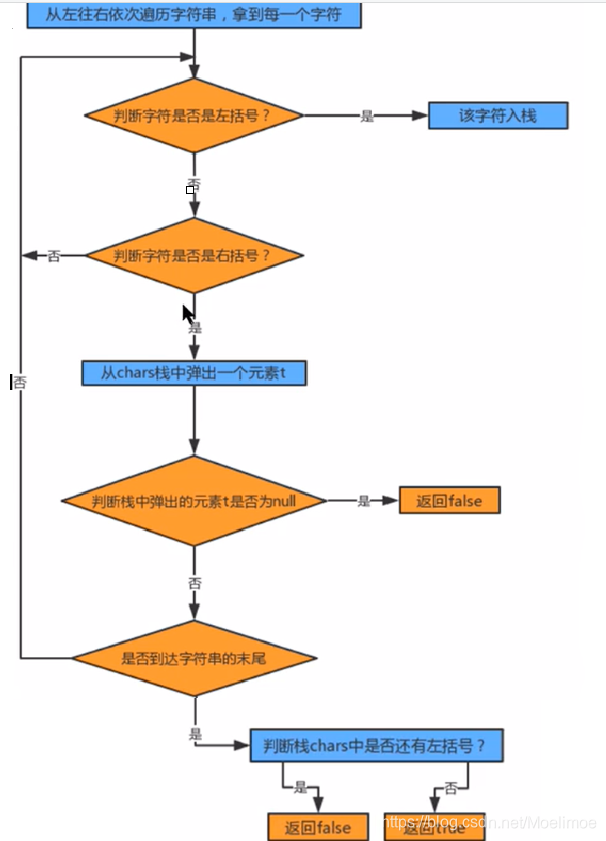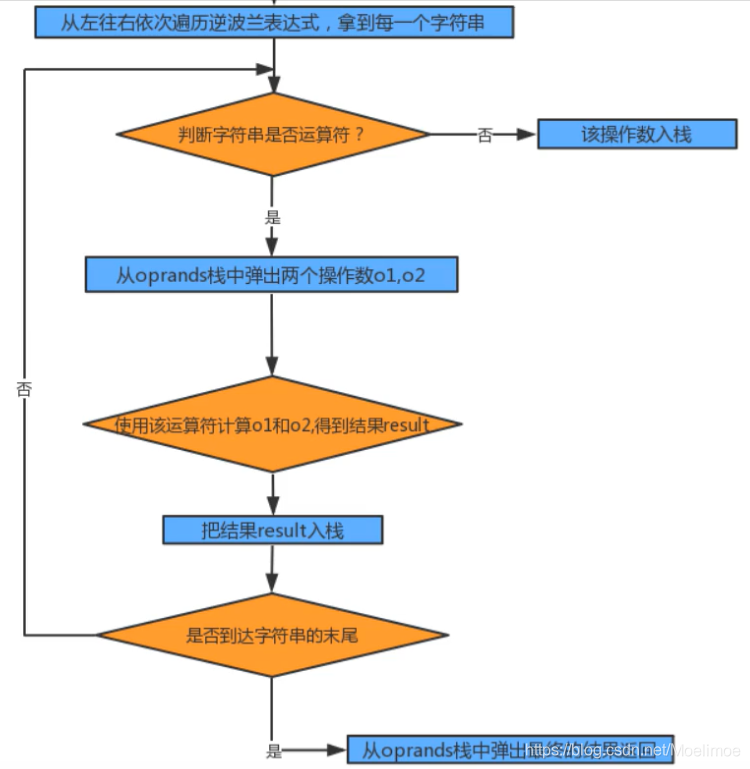括号匹配问题和逆波兰表达式求值问题
基于上一节已经使用python代码对栈进行了简单的实现,这一节我们在其基础上解决两个常见的问题
案例
- 括号匹配问题(点我直接到代码实现)
- 逆波兰表达式求值问题(点我直接到代码实现)
括号匹配问题
在给定的字符串中,编写程序实现确定该字符串类的括号是否匹配的问题

使用栈解决这个问题的思路:

括号匹配python代码实现
from Structure.linear.Stack import Stack
def is_matched_brackets(_str=None):
stack = Stack()
for s in _strs:
# If the sub-str is '(', push it into the stack
if s == '(':
stack.push(s)
# If it is ')', try to pop a '(' from the stack
elif s == ')':
pop_a_left = stack.pop()
# If hadn't popped a '(', return false
if not pop_a_left:
return False
if stack.len == 0:
return True
return False
# _strs = "()(Shanghai)(Changan))("
# _strs = "())("
_strs = "(())()"
print(f"Is the brackets matched in {_strs} ? {is_matched_brackets(_strs)}")
然后这里导入的Stack是上一节栈的实现写的代码,也就使用到了pop和push的方法以及len属性,代码量也不算很多,我就直接复制过来了,方便查看,这里功能实现起来也是非常的简单,就不做过多赘述来解释了。
class Node:
def __init__(self, item):
self.item = item
self.next = None
class Stack:
def __init__(self):
self.head = None
self.len = 0
def is_empty(self):
return not self.len
# def length(self):
# return self.len
def push(self, item):
"""Push an element into the stack"""
node = Node(item)
node.next = self.head
self.head = node
self.len += 1
def pop(self):
"""Pop a value from the stack top"""
# if not self.head:
# raise IndexError("pop from empty list")
cur = self.head
if self.head:
self.head = self.head.next
self.len -= 1
return cur
逆波兰表达式
在定义逆波兰表达式求值问题之前,我们先来看一下中缀表达式是什么:
- 定义:中缀表达式是一个通用的算术或逻辑公式表示方法,二元运算符总是会在两个操作数的中间
举个栗子:
- 例如:1 + 3 * 2和2 - ( 1 + 3 ),运算符(+ - * /)都是在两个值的中间
这种表达式虽然对于我们人类来说观看和使用起来都是非常简单的,但是对于计算机并不太友好,这是因为这种表达式并不是有顺序的,在运算时还可能涉及到很多优先级顺序的判断
因此我们引入了中缀表达式转后缀表达式的概念,这里的后缀表达式就是我们所说的逆波兰表达式
- 简介:逆波兰式(Reverse Polish notation,RPN,或逆波兰记法),也叫后缀表达式(将运算符写在操作数之后)
逆波兰表达式的定义描述看起来晦涩难懂,简单的说就是将运算符写在操作数之后的表达式,对定义描述感兴趣的同学可以自行百度一下,这里我们用几个例子直观的感受一下

通过结果看转换前的状态会比较好理解:
- a + b →
ab+,先看操作符,一个操作符对应两个值,加号+对应a 和 b相加得到a+b - a + (b - c) →
abc-+,先看操作符,一个操作符对应两个值,减号-对应离他最近的bc,因此先计算b - c,再看加号+,也对于两个值,就是a 和 (b - c),因此为 a + (b - c) - a + (b -c) * d →
abc-d*+,先看操作符,秉承操作运算的先后顺序,减号-对应b - c,然后乘号*对应的是(b - c)*d,最后加号+对应的也是两个值a 和 (b - c)*d相加即可得到a + (b - c) * d - a * (b - c) + d →
abc-*d+,同样,以操作符为中心寻找数字,减号-对应b 和 c相减得到(b - c),乘号*对应a 和 (b - c)相乘得到a * (b - c),加号+对应a * (b - c)和 d,相加得到结果 a * (b - c) + d
代码实现思路:
- 如果当前字符为变量或者为数字,则压栈,如果是运算符,则将栈顶两个元素弹出作相应运算,结果再入栈,最后当表达式扫描完后,栈里的就是结果。
实现流程图:

python代码实现
这里先要写一个实现栈的类方法:(也可以参照前期的栈实现文章)
class Node:
def __init__(self, item):
self.item = item
self.next = None
class Stack:
def __init__(self):
self.head = None
self.len = 0
def is_empty(self):
return not self.len
# def length(self):
# return self.len
def push(self, item):
"""Push an element into the stack"""
node = Node(item)
node.next = self.head
self.head = node
self.len += 1
def pop(self):
"""Pop a value from the stack top"""
# if not self.head:
# raise IndexError("pop from empty list")
cur = self.head
if self.head:
self.head = self.head.next
self.len -= 1
return cur
from Structure.linear.Stack import Stack
def reverse_polish_notation(_strs):
nums = Stack()
for s in _strs:
if s not in ['+', '-', '*', '/']:
nums.push(s)
else:
num1 = nums.pop().item
num2 = nums.pop().item
# This equals to num2 [+-*/] num1
res = eval(str(num2)+s+str(num1))
nums.push(res)
return nums.pop().item
# 2*(18-13)-12/4 = 2*5 - 3 = 7
_strs = '2', '18', '13', '-', '*', '12', '4', '/', '-'
result = reverse_polish_notation(_strs)
print(f"The computation of {_strs} is {2*(18-13)-12/4}")
print(f"The result is {result}")
运行结果:
The computation of ('2', '18', '13', '-', '*', '12', '4', '/', '-') is 7.0
The result is 7.0
实现过程比较简单,就不过多赘述了





 本文介绍了如何利用栈数据结构解决括号匹配问题和逆波兰表达式求值问题,详细解析了算法思路并提供了Python代码实现。
本文介绍了如何利用栈数据结构解决括号匹配问题和逆波兰表达式求值问题,详细解析了算法思路并提供了Python代码实现。
















 696
696

 被折叠的 条评论
为什么被折叠?
被折叠的 条评论
为什么被折叠?








